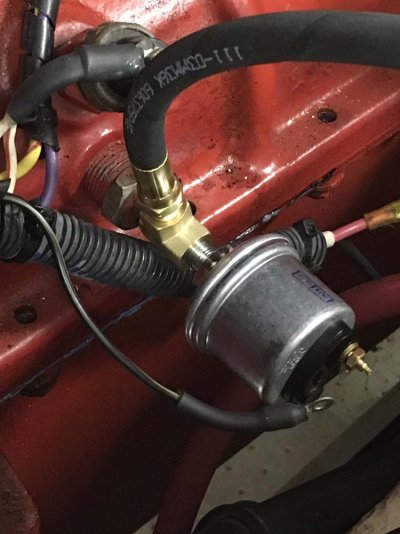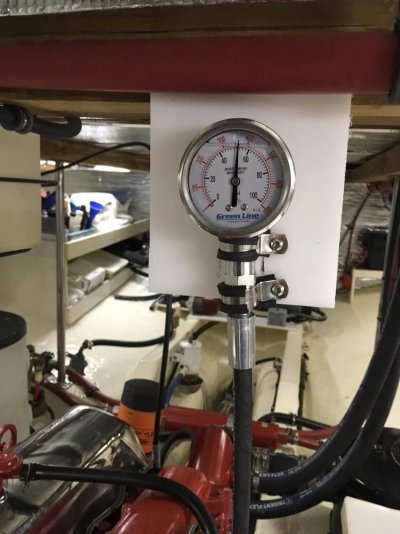I'm not super bothered by the 6-8vdc that you are reporting, only because I don't know exactly how it is being measured or what is being measured -- and for many designs and situations that could be fine.
Different designs are certainly possible, but classically, these gauges work by using coils to generate a magnetic field to deflect the needle. Usually there are at least two opposing coils, one which pulls the needle one way and the other which pulls the needle the other way. They can be configured so the position of the needle depends upon how much current is shunted through the sender and away from one of the coils, or how much current passes through one coil, adjusted by the sender, as compared to how much current passes through the other coil via a reference resistor. They can also be configured with three coils, such that two coils are in balance, and a third coil is used to "buck" or oppose one of them, allowing the flow through the other coil, also as controlled by the resistor, to control how much. The key to any of these designs is that they are "balanced". In other words, there is a left pull and a right pull driven by the same voltage source, each across a calibrated coil, so that whatever the voltage is, it balances out and doesn't affect the reading, at least within reason. Too little and there won't be enough current to drive the electromagnets to move the needle, and too much and the current will be too high and something will burn.
Where I'm going with this is that, with the sender disconnected, if you measured a 2-coil gauge from 12v to sender, you are measuring the voltage drop across one but not across both coils. So, I'd expect it to be less than 12v. If you measured it with the sender connected, the sender and the 2nd coil would be in parallel, so you'd be measuring the voltage drop across the 1st coil, but not including that parallel load.
In a 3-coil gauge, with the sender disconnected, you'd be measuring the voltage drop across the low coil, but not also across the high and bucking coils. If the sender were connected, you'd be measuring the drop across the low coil, but not also across the parallel load of the bucking and high coils plus the sender.
In ay of the above configurations, we've got a voltage divider and you are measuring the drop across the left half of it, not all of it. If you'd want to measure all of it, you'd have to measure between 12v and ground -- which you did, and you know is correct.
If you were seeing the same thing 12v-to-gnd as you were seeing 12v-to-sender, that's when I'd be concerned. The only time I think you should see that is if the sender wire is grounded, e.g. the sender has a 0 resistance.
And, again, I don't actually know what gauges you have or how they work. I'm just suggesting that in most balanced gauges, sender wire voltage being different from ignition voltage would be a red herring, not diagnostic information.
I really encourage you to do some of the debugging I mentioned earlier:
-- What happens if you disconnect the sending wire at the sender?
-- What happens if you ground it?
-- Does the above generate two different extreme gauge readings?
-- What about if the sender wire is grounded and opened right at the gauge (versus at the sender)?
-- If you have a resistor that is somewhere in the middle of the gauge range, what happens if you disconnect the gauge sender wire, wire it to ground through that resistor, and turn on the power? Does it read mid-way?
-- With the engine off and the wire disconnected from the sender, how many ohms do you read from the sender to ground? What about with the engine running normally? How do these look compared to the values in the table I posted?
-- With everything powered off, how many ohms do you read between the gauges ground wire and another known-good electrical ground?
-- With the sender wire disconnected at the sender and at the gauge and everything powered off, how many ohms do you read gauge-side sender wire to ground? To 12v?
-- What if you do the above at the sender side?
-- With the sender wire disconnected on both sides and everything powered on, how many volts do you read to each of 12v and ground? Measure on both sides.
-- With everything hooked up and powered up, how many volts do you read to ground at the back of the gauge sender wire terminal? What about at the other end of that wire where it meets the sender?
The goal here is to find the gauge not moving from one extreme to another, and, if you can test it, being able to sit in between (though this would be a weird failure case); to to find the sender failing to have the proper resistance at 0ps and/or failing to change resistance as oil pressure changes; to find the sender wire shorted to ground; to find the sender wire shorted to 12v; to be able to find the sender wire having a low-resistance path to either; or finding the sender wire, itself, has high resistance from end-to-end.




